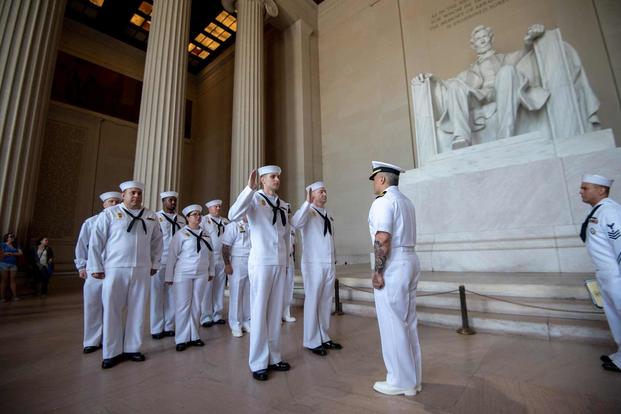The Navy is moving away from the "suck it up, buttercup"-style culture of the past to appeal to the millennial generation and beyond -- and new retention numbers indicate the approach is likely working.
The service blasted past its 2019 retention goals for enlisted sailors in their first 10 years in uniform. It held onto nearly 65% of Zone A sailors, or those with less than six years in. And 72% of Zone B sailors -- those with six to 10 years in -- re-upped.
The Navy set out to keep at least 55% of sailors in Zone A and 65% of those in Zone B. When combined with Zone C sailors, those who've been in the service for 10 to 14 years, the 2019 reenlistment rate was 74% across the three zones.
Fleet Master Chief Wes Koshoffer, with Navy Manpower, Personnel, Training and Education, told reporters the high re-up rates are a result of an ongoing culture shift in the Navy. Leaders are listening to rank-and-file sailors, he said, and the Navy is focused on developing policies based on what's easier for the individual and their family.
Related: Child Care Remains a Retention Priority, Navy's Top NCO Says
"When I was a very, very young sailor in the Navy, facing a particularly challenging ... family situation, the moniker was, 'Family didn't come in your seabag, shipmate. We need you,'" Koshoffer said. "That is no longer our mantra."
The entire military faces recruiting and retention challenges when it's up against a booming economy. People have job options outside the service, Koshoffer said. Being an appealing career choice for today's generation of sailors is crucial as the Navy builds its force back up to 340,500 personnel as it faces more sophisticated threats.
That's up from a 2012 end-strength low of 318,000 enlisted sailors and naval officers.
"We're going to need a bigger Navy," the fleet master chief said. "[We have] a different national strategy, a different military and Navy strategy. … In order to really grow at the pace we want to grow, you have to have these high retention numbers."
Yeoman 2nd Class Thomas Mahoney and Personnel Specialist 1st Class Holly Tucker say they've seen Navy culture change during their time in the service. Mahoney, 26, will soon reenlist for the second time. Tucker, 25, re-upped last year.
Mahoney was on an aircraft carrier when two destroyers in the Pacific suffered separate fatal collisions. When lack of sleep was found to have contributed to the accidents, Mahoney said leaders in 7th Fleet reacted immediately.
More rotational watch schedules were added, and other steps were taken to ensure people were getting good sleep while deployed, he said.
That's a big shift, Koshoffer said. "Our attitude toward sleep [used to be], 'You'll sleep when you're dead,'" he said. "We've changed that."
Tucker cited the military's 12-week maternity leave policy as contributing to her decision to stay in the Navy. The service's maternity leave policy briefly tripled from six weeks to 18 under former Navy Secretary Ray Mabus. In 2016, then-Defense Secretary Ash Carter announced all the services would receive 12 weeks.
"I think that's a great incentive for women specifically," Tucker said, adding that she values her leadership's support and understanding on family matters.
Related: Marines' New Top Officer Wants to Give New Moms a Full Year Off
The millennial generation is also focused on career progression and flexibility, the Navy found. Koshoffer said leaders are shifting the service's culture to show sailors they're listening and responding to what they're looking for in a Navy career.
After years of complaints about the Navy's career detailing program being too secretive, for example, the service unveiled a new online database called My Navy Assignment. The tool is meant to give sailors more information about requirements they'll need for their jobs of choice so they can build up their skills well before their detailing window hits.
So far, about 11,000 sailors have used the tool to bookmark 27,000 jobs.
"The reason why we show every job available to the sailors was sailor demand for transparency," Koshoffer said. "... We heard you, we listened, we made the change."
Change is what the Navy must do in order to compete for top talent, the fleet master chief added. The service still relies on reenlistment bonuses to entice those in hard-to-fill jobs to stay in uniform. Tucker, for example, was eligible for an extra $9,000 when she reenlisted.
But the Navy must also embrace telework, flex hours and job-sharing options, Koshoffer said.
"The nature of work is changing," he said. "... That would be heresy in some circles that in the Navy, we would allow somebody to telework. Are you kidding me?
"But we recognize that we've got to adapt to a modern lifestyle and world out there."
-- Gina Harkins can be reached at gina.harkins@military.com. Follow her on Twitter @ginaaharkins.
Read more: Navy Changes Tour Lengths for 50,000 Sailors and Boosts Reenlistment Bonuses












